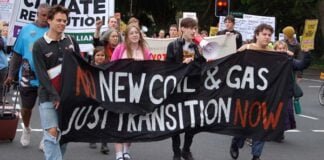Tony Abbott’s contempt for climate change has again been on display over the efforts to lower the Renewable Energy Target (RET). The RET mandates a proportion of total energy use that must come from renewable sources such as solar panels and wind farms.
Even after Labor agreed to a lowering of the target by 20 per cent, at the last minute the Liberals insisted that burning woodchips be included as renewable energy. The Liberals had originally wanted it cut 30 per cent.
The attack on the RET has already seen investment in renewable energy decline by 90 per cent over the last year.
Meanwhile, as Tony Abbott’s Direct Action climate policy is underway, it continues to be widely, and rightly, derided.
Direct Action is based on a laughable target of 5 per cent emissions reduction by 2020 relative to 2000 levels. To reach this target the government operates a tendering process where businesses compete for contracts to reduce emissions. The most cost-effective proposals are then funded out of a $2.55 billion “Emissions Reduction Fund”.
The first round in April handed out 25 per cent of the total fund to secure on paper 47.3 million tonnes of emission reductions. However this is only 17 per cent of the emission reductions needed to successfully achieve the 2020 target. This shortfall is likely to increase as the cheapest emissions reduction projects are exhausted. There is also no guarantee that proposals will achieve the emissions reductions they have pledged.
The first auction overwhelmingly funded carbon offsets. One example is avoided deforestation, where farmers agree not to clear land. This may have merit, but it is hard to tell whether it is actually additional reduction, or land that would not have been cleared anyway.
And such projects don’t deal with the fundamental problem of how energy is produced.
Direct Action also establishes an emissions threshold, or “safeguard mechanism” enforced by fines, to stop increased emissions across the rest of the economy. This will be lowered over time and is due to start on 1 July 2016.
Although this targets large emitters and will cover 55 per cent of total emissions, it is set so as to minimise costs to polluters. The threshold for a company is set at their highest reported emissions over the period 2009-2014. Companies can apply for an adjustment to increase their threshold further.
Energy companies, the largest single source of Australia’s emissions, get further leeway. Their thresholds will be calculated on an industry level not for each facility.
As Environment Victoria explained: “the only thing that this proposed mechanism safeguards is a continued free ride for polluting coal-fired power stations”. To make matter worse carbon offsets will be available for polluters to cheaply buy their way out of trouble.
What’s the alternative?
Direct Action is a joke. But Labor and The Greens’ alternative of emissions trading is no better. Labor remains committed to the same pathetic target as Abbott, of 5 per cent emissions cuts.
Even at a higher target, emission trading means polluters will simply pass the cost of the carbon price onto consumers. This is why Abbott could paint it as an attack on living standards.
Instead of actually building the large scale renewable, Treasury predictions were that Labor’s scheme would have primarily driven an expansion in gas.
As campaign group Beyond Zero Emissions (BZE) has convincingly argued, it is already feasible to achieve 100 per cent renewable energy through concentrated solar thermal, wind and rooftop solar energy.
Tesla’s recently announced household-scale battery, which for a few thousand dollars can store solar energy for use when the sun isn’t shining, further demonstrates the technological possibilities.
Even AGL, one of Australia’s giant energy companies, said recently it expects not be operating any coal-fired power plants by 2050.
But unless the government actually invests in large-scale renewable energy, deep emission reductions won’t be possible. BZE’s proposals of large-scale solar plants and high-speed rail between Sydney, Melbourne and Brisbane could cut emissions drastically.
However only the government will fund such projects given the scale and cost. Hence addressing climate change requires challenging the neo-liberal logic of leaving everything to the market.
A transition to 100 per cent renewables is affordable. Renewable energy costs have fallen by 25 per cent in the last three years, and will fall further. BZE estimates the cost of high-speed rail as $80 billion over ten years, equivalent to one year of current road spending. If we taxe the polluting corporations and the rich, the money is there.
But it will requires a mass movement to challenge big polluting industries and the neo-liberal political consensus.
By Eliot Hoving





